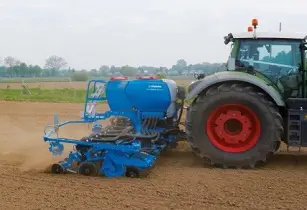LEMKEN has launched its latest precision seed drill equipment, the Azurit 10
The Azurit 10 has enhanced features and a number of benefits, compared to the previous model and will be available for sale from September.
The new Azurit comes with six or twelve rows, with a 50-cm row spacing and a furrow former, that has been added to the seeding coulters to improve the quality of seed placement. The drill pipe now comes with an inlet, that can be replaced once worn.
From the coming season, the range of applications of the Azurit 10 will be applicable to additional crops, such as soy beans and sunflowers. Another new feature, which can be retrofitted to older machines, is the automatic seed singling for maize. It is a system that monitors and adjusts the quality of seed singling. The fertiliser monitoring system, on the other hand, automatically alerts the operator if individual fertiliser coulters become blocked.
LEMKEN also offers the MicroHub 5, a spreader unit which allows microgranule to be applied in the direct vicinity of seeds. Microgranules contain water-soluble nutrients, which are rapidly available to plants and therefore, generally produce excellent juvenile crop development. This is particularly important in cold, dry spring seasons. The initial nutrient requirements of crops can be easily covered by relatively small amounts of microgranules.
LEMKEN’s emphasis on fertiliser efficiency with the MicroHub 5, is noteworthy, as the topic is gaining grounds in public discussions. “We offer this option for our Azurit with up to eight rows,” said Bernd Valtwies, LEMKEN’s head of design for precision seed drill technology. “This unit is not only available for new machines. Depending on the year of manufacture of previous Azurit 9 machines, matching retrofit kits will be available. The system is controlled via the Azurit on-board terminal. The MicroHub holds 200 litres of fertiliser, which can currently be applied at rates ranging from 1 to 40 kilos per hectare. The metering unit is operated electrically and granules are pneumatically delivered to the seed furrow. This is the ultimate in precision,” enthused Valtwies.








